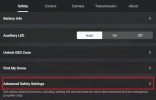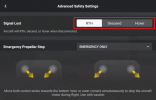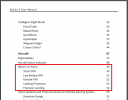Therefore, on RTH, if either drone encounters an object, whether it be land, a tree, a roof, or whatever, it in theory should avoid it? Even if it had been set to raise (RTH altitude) to the height where it would encounter such an object?I would think it does
looking at a pic I notice the two sensors mounted on the Front-back aimed up and towards the back.
View attachment 171868
You are using an out of date browser. It may not display this or other websites correctly.
You should upgrade or use an alternative browser.
You should upgrade or use an alternative browser.
Settings?
- Thread starter Droner56
- Start date
Cafguy
Well-Known Member
Cafguy
Well-Known Member
Yep- OA Never has been good for anything small such as that. and Water can confuse the sensors(light off the water)-Sometimes.And my guess is that OA isn't reliable around high strung wires/cables, thin branches, or bodies of water?
Much appreciated.Yep- OA Never has been good for anything small such as that. and Water can confuse the sensors(light off the water)-Sometimes.
- Joined
- Oct 12, 2016
- Messages
- 30,373
- Reactions
- 34,325
- Location
- Harrisburg, PA (US)
- Site
- mavichelp.com
The Mini 4 Pro is there now.From the link the previous poster included, the Air 3 has the same sensors as the Mavic 3 series (front, back, sides, top, bottom). The Mini 4 Pro isn't mentioned in that list, but my guess is it has the same sensor arrangement as well. Doesn't that mean that they both have OA on top?
And yes, it does have upward sensors. However, the sensors aren't 100% accurate, so I don't know that I would fully trust them to prevent a crash in an RTH scenario. It would be safest to set the drone to hover or land when RTH is initiated in a scenario like you mentioned.
I see. And the sensors in the Mavic 3 series aren't any more accurate than in the Air 3 or Mini 4 Pro?The Mini 4 Pro is there now.
And yes, it does have upward sensors. However, the sensors aren't 100% accurate, so I don't know that I would fully trust them to prevent a crash in an RTH scenario. It would be safest to set the drone to hover or land when RTH is initiated in a scenario like you mentioned.
And that setting, where you can set what to do when RTH is selected, it can be changed while the drone is out flying some distance away?
- Joined
- Oct 12, 2016
- Messages
- 30,373
- Reactions
- 34,325
- Location
- Harrisburg, PA (US)
- Site
- mavichelp.com
The setting I'm referring to only covers the scenario where RTH is automatically initiated after the remote controller signal is lost. You can find that setting here in DJI Fly:where you can set what to do when RTH is selected, it can be changed while the drone is out flying some distance away?


If you know there are obstacles above the drone, then you shouldn't attempt to manually initiate RTH.
Droning on and on...
Well-Known Member
And so it stopped at that point? Awesome. I wonder if the Air 3 would do the same. Sorry, as a newbie, I'd misunderstood how RTH worked exactly, but experimented with it yesterday. Unless I'm mistaken, regardless of how high the RTH-altitude is set, the drone will not rise to that level if the home point can be reached by simply flying horizontally (and then descend) from where the drone is positioned in the air when you push RTH.The M4P has full spherical OA. just experienced it vertical yesterday trying to ascend under a tree. Set to brake, it refused to ascend, and the "radar" oval in the display indicated an obstruction 3ft overhead.
- Joined
- Oct 12, 2016
- Messages
- 30,373
- Reactions
- 34,325
- Location
- Harrisburg, PA (US)
- Site
- mavichelp.com
@Droner56 RTH do you have a copy of the Air 3 manual? It covers the various RTH scenarios you should be aware of.
Yes, thanks, thought I hadn't seen that issue covered in the manual, but perhaps I'm not as familiar with it as I could be.@Droner56 RTH do you have a copy of the Air 3 manual? It covers the various RTH scenarios you should be aware of.
- Joined
- Oct 12, 2016
- Messages
- 30,373
- Reactions
- 34,325
- Location
- Harrisburg, PA (US)
- Site
- mavichelp.com
Yes, I see now. The explanation of RTH features are very detailed. Overall, I’m impressed with DJI. They fit a surprising amount of engineering into these small units. Both hardware and software.
No need to guess.And my guess is that OA isn't reliable around high strung wires/cables, thin branches, or bodies of water?
The OA system is good, but not magic.
There are several situations that it might have difficulty with.
This is from p. 57 of the Air 3 manual.
Note the last point.
The vision systems cannot work properly near surfaces without clear pattern variations or where the light is too weak or too strong.
The vision systems cannot work properly in the following situations:
a. Flying near monochrome surfaces (e.g., pure black, white, red, or green).
b. Flying near highly reflective surfaces.
c. Flying near water or transparent surfaces.
d. Flying near moving surfaces or objects.
e. Flying in an area with frequent and drastic lighting changes.
f. Flying near extremely dark (< 10 lux) or bright (> 40,000 lux) surfaces.
g. Flying near surfaces that strongly reflect or absorb infrared waves (e.g., mirrors).
h. Flying near surfaces without clear patterns or textures.
i. Flying near surfaces with repeating identical patterns or textures (e.g., tiles with the same design).
j. Flying near obstacles with small surface areas (e.g., tree branches and power lines).
Similar threads
- Replies
- 3
- Views
- 1K
- Replies
- 5
- Views
- 955
- Replies
- 0
- Views
- 200
DJI Drone Deals
New Threads
-
-
Mini 3 Cumulonimbus Shots with the mini 3
- Started by Dan'sUavTech
- Replies: 2
-
-
-











